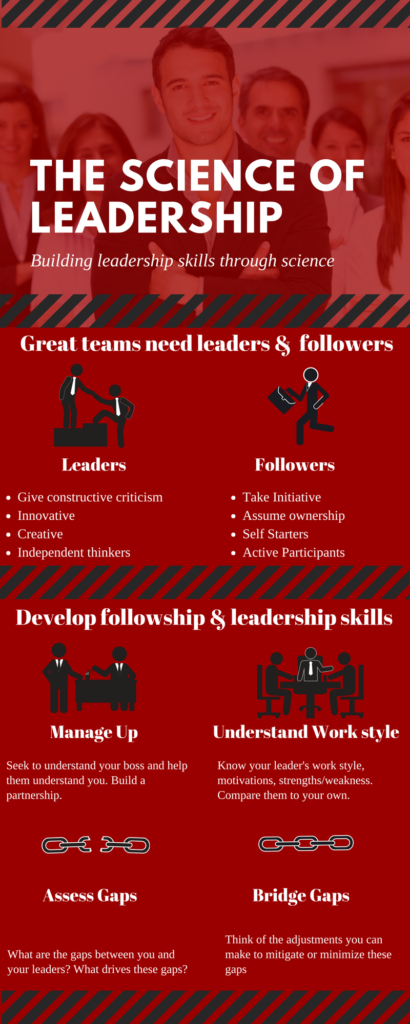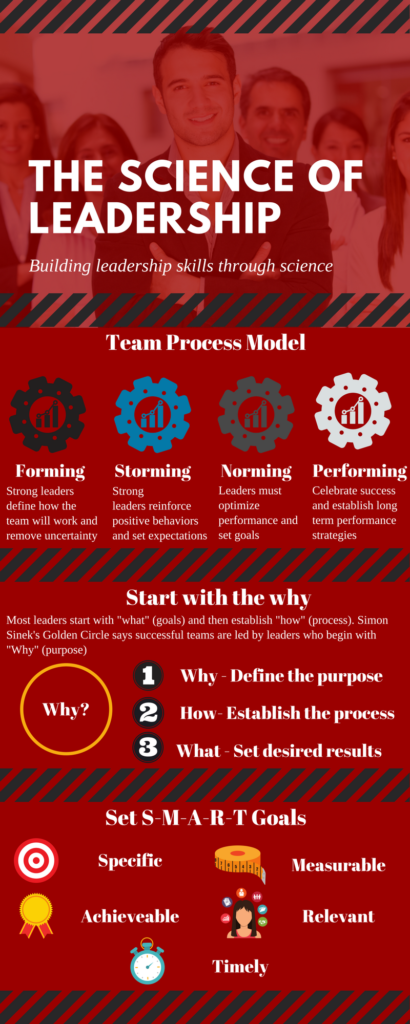Build Your Leadership Skills Using Science
By leveraging the best thinking and proven concepts from the study of leadership and human behavior, we can become better leaders regardless of our title or our place in the organizational hierarchy. The healthcare industry’s rapid growth is creating an increased demand for skilled leaders. Recently, Clinical Assistant Professors Erik Burns, EdD and Brett Kelly, MS of The School of Pharmacy Division of Pharmacy Professional Development addressed this growing need in their presentation on leadership skill development given at the annual meeting of the American Association of Pharmaceutical Scientists (AAPS).
This article highlights some of the topics covered in that presentation, including three key approaches you can use to take your leadership skills – and your team – to the next level of success.
Leading Through Following
New team members have less formal authority than they need to carry out their responsibilities. Effective, innovative managers know how to use informal and indirect authority to influence key stakeholders: the boss, peers, associates, customers, suppliers, and staff.
In order for any organization to be successful, it must have both effective followers and leaders. Everyone serves as a follower or leader at different times throughout their career, and anyone can be a leader if they develop the necessary skills. The ability to understand how to leverage your role as a follower or leader at the appropriate time is key to your success. In order to be a good leader, you must also embrace the role of follower.
A follower supports leaders and colleagues as a partner to help achieve a shared vision. Research suggests that two key traits that are common to effective followers are independence/critical thinking and active engagement in the workplace
Independent/critical thinkers:
- Give constructive criticism
- Are innovative
- Are strong individuals who think for themselves
- Are creative
Followers who are actively engaged in their work tend to:
- Take initiative
- Assume ownership
- Actively participate in work activities
- Be self-starters.
Strong followers who embody these traits are generally high performing in the workplace, making the job of leaders easier.
Aspiring leaders should first seek to maximize their “followship” skills by exhibiting awareness, diplomacy, courage, collaboration, cultural competency, and critical thinking skills in service of a shared goal, vision or mission. While these skills are the hallmark of strong followers, it’s no coincidence that many of these are also key behaviors of strong leaders. Leaders who practice these skills are better able to relate to the needs of followers. With the help of tools like a Followship Style Assessment, WorkStyle Evaluation, Role Worksheets, or the Situational Leadership II Model, these practical approaches can help develop both your follower and leadership skills:
- Manage up: Actively seek to better understand your boss, help them better understand you and use these distinctions to create a more effective partnership
- Learn your leader’s workstyles, motivations, strengths/weaknesses, and expectations. Consider how they compare to your own.
- Assess any “gaps” between you and your leaders. Are any gaps driven by personality? Style? Organizational structure?
- With this understanding, think about what adjustments you can make to mitigate or minimize these gaps.
Translation of Leading and Following
Creating an environment for sustained success is obvious need, but how is this accomplished? How do you encourage higher performance from your staff?
One of a leader’s key roles is to create an environment of sustained success. This results in a situation where followers are consistently achieving their goals while experiencing high levels of fulfillment. Part of this process requires the leader to identify and remove roadblocks that can prevent a team from reaching its fullest potential as well as creating a process to allow for the constructive resolution of the inevitable conflicts that will arise. Finally, effective leaders facilitate change to allow their teams to continue to evolve in a healthy and organic manner.
As we all know, guiding effective teams is a key requirement of leadership. However, this is not an easy skill. Aspiring leaders who understand the stages of team formation are at an advantage in coaxing high performance out of their team as efficiently as possible. The most common formulation of the team cycle is the “Forming, Storming, Norming, and Performing” model.
- In the Forming stage, roles and processes are unclear, presenting strong leaders with an obligation to take a hands-on role with an opportunity to quickly define how the team will work.
- In the Storming stage, the team’s purpose has been established, but relationships are often still blurry and team efforts can be halting and tentative. This provides leaders with an opportunity to reinforce positive team behaviors and normalize communications and expectations.
- Next, the Norming stage is when relationships begin to settle and commitment to team goals begins to manifest. The leader’s role now is to continue positive reinforcement and to look for ways to optimize team performance, taking it from good to great.
- When that is accomplished, the team enters the Performing phase. High performance is a shared goal, and the team requires little guidance. Smart leaders at this stage know to focus on strategy rather than team management, and to celebrate and reward the team’s continued success.
In order for organizations to succeed, performance must be sustained and efficient, meaning that results must be met with minimal wasted effort or resources. It is imperative that leaders anticipate the needs of their teams as well as potential challenges and proactively put strategies and processes in place to address them. By doing so, leaders will feel more confident and this will translate to a more confident team.
One of the most important and useful concepts in leadership is Simon Sinek’s “Golden Circle” model, which posits that in order to be successful, every leader and organization must know their “what,” “how,” and “why.” The outer ring of this Golden Circle is “What.” This is the easiest part of the circle to identify because it’s the answer to the simple question of what the job is, or what service or product is being offered. The second ring of the circle is also generally easy to identify: the “How.” What style, method, and processes are employed?
The key to successful leadership, however, is the “Why.” Though seldom explicitly identified, the reasons for doing what we do in the workplace are at the core of effective communications and vision. What is the core purpose or belief that drives what we do and how we do it? Why do we get up every morning to do our work, and why should anyone else care? Answering the “why” question is a critical step for every leader because it provides the foundation for communicating, motivating, and inspiring teams.
Leaders who understand important concepts like “Start with Why,” and the stages of team formation are better able to avoid the common causes of team failure, such as a displaced environment, cultural barriers, misaligned goals, role confusion, and process gaps. Tools like the Team Cohesiveness Assessment and the Modified Self-Perception Inventory are also very useful here. Here are a few practical steps you can take to improve performance today:
- Assess and establish clear team roles
- Align your team around clear, measurable, attainable goals
- Anticipate and clear roadblocks for your team
- Look for ways to build trusting relationships with your team members
Setting and Meeting Organizational Objectives
One of the most important responsibilities of any team is understanding their roles within the larger organizational structure. This includes making sure that their team understanding processes, structures, behaviors, and competencies, are properly aligned with overall strategy.
An organization’s ability to identify clear strategic objectives, communicate those objectives to its employees and engage employee efforts directly to meet those objectives is key to its success. Ideally, this process takes the form of ongoing dialogue and collaboration between managers and employees within a well-defined structure that allows for input from both parties, increasing buy in, commitment, and performance.
The setting of effective goals at both the individual and team level not only engages everyone’s efforts toward critical outcomes, but also serves to engage and motivate employees. The most common framework for goal-setting is the SMART concept. SMART goals remove ambiguity and promote unity of purpose by being specific, measurable, attainable, relevant, and timely (hence, “SMART!”).
Specific goals are simply written and clearly define what is to be accomplished. Measurable goals have clear, numeric achievement targets that can be baselined and regularly monitored. Attainable goals have a reasonable chance of success, given available resources—even if it’s a bit of a stretch. Relevant goals align with organizational goals and other efforts and are owned by the right people at the right time. And finally, timely goals have a clear timeframe that reflects reality, but also creates urgency. SMART goals are all of these, and can greatly enhance performance by serving as clarifying points of focus for well-defined team success.
When done correctly, effective performance management helps employees perform at their highest level while giving them the satisfaction of knowing that their work matters and is contributing to a larger purpose. Leaders who understand the value of performance management and appraisal through SMART goals, along with mastery of a range of methods like Behaviorally Anchored Rating Scales and Management by Objectives (MBO), are better able to build high-performing teams and organizations. Here are some approaches you can try today to help build your performance management efforts:
- Develop your own goals to practice setting SMART goals and evaluating performance appraisal models
- Find mentors to help assess your performance and to gain their perspective on evaluating performance
- Seek regular feedback from subordinates, peers, and superiors for a well-rounded view of your performance
- Offer feedback on your organization’s performance management process based on what you observe
By combining the latest in neuroscience and both classic and emerging best practices in organizational management, these approaches describe the essentials of leadership in PharmSci. Identifying personal leadership styles and learning how to choose the right roles/career path to fit that style are keys for pharma professionals who will be called upon to lead through following, guide high-performing teams, or even lead organizations to success.
Leadership Skills Training at Pharmacy Professional Development
The Division of Pharmacy Professional Development has developed leadership courses to help aspiring leaders in the industry. Leadership for Inspiring a Powerful Healthcare Team is a new course that taught by Mark Brouker of Brouker Leadership Solutions. Mark Brouker combines his leadership experience in the United States Navy with his education as a Pharmacist to give military inspired leadership coaching to current and aspiring leaders in Healthcare. CMC Project Team Leadership is one of the required courses in our Applied Drug Development Certificate. This course developed in partnership with Zeeh Pharmaceutical Experiment Station gives pharmaceutical scientists valuable leadership training to manage CMC Project teams in the drug development process. Our Land O’ Lakes Conference series is a great resource for everyone in the pharmaceutical industry to connect with thought leaders and pioneers. We also provide custom training combining science and soft skills tailored to meet organizational needs.
